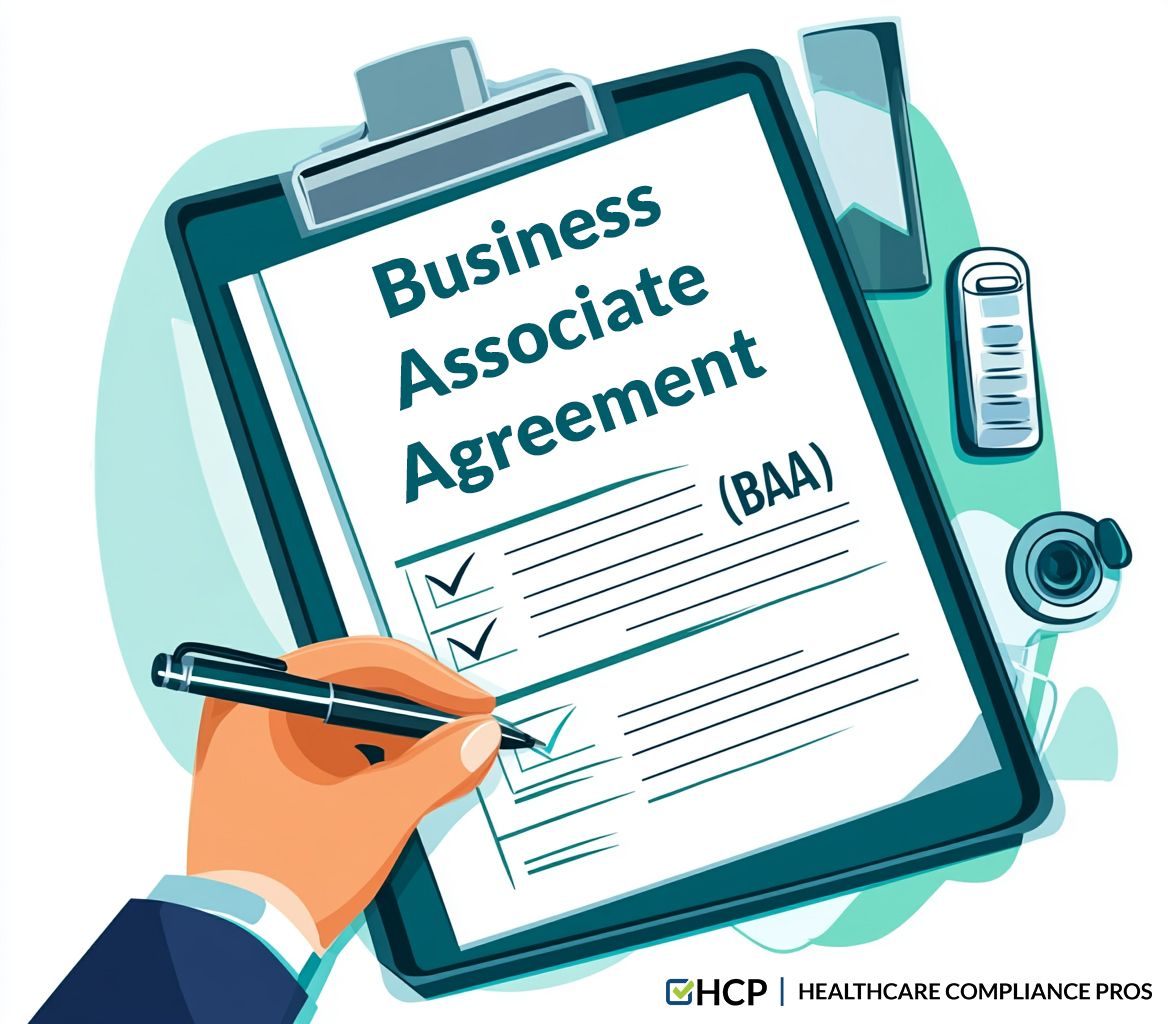Introduction
Understanding HIPAA Business Associate Agreements (BAA) for Covered Entities
Safeguarding patient information isn't just a legal obligation—it's a cornerstone of patient trust and the integrity of healthcare organizations. The Health Insurance Portability and Accountability Act (HIPAA) sets strict standards for protecting sensitive patient data, known as Protected Health Information (PHI). The Business Associate Agreement (BAA) is a critical yet often misunderstood component that binds HIPAA-covered entities and their business associates to a shared responsibility to protect PHI.
Imagine a healthcare provider facing hefty fines and reputational damage because a third-party vendor mishandled patient data. This scenario isn't hypothetical; it's a real risk for organizations that fail to implement and manage BAAs properly. This comprehensive guide demystifies BAAs, addresses common misconceptions, highlights overlooked aspects, and provides actionable steps to ensure your organization remains compliant and trusted.
What is a Business Associate Agreement (BAA)?

A Business Associate Agreement (BAA) is a legally binding contract between a covered entity and a business associate. Under HIPAA:
- Covered Entities include healthcare providers, health plans, and healthcare clearinghouses that transmit health information electronically.
- Business Associates are individuals or entities that perform activities involving the use or disclosure of PHI on behalf of a covered entity. This includes services like billing, data analysis, cloud storage, and IT support.
Protected Health Information (PHI) encompasses any information about health status, healthcare provision, or payment for healthcare that can be linked to an individual. When PHI is transmitted or maintained in electronic media, it's called Electronic Protected Health Information (ePHI).
The Necessity of BAAs for HIPAA Compliance
1. Legal Obligations Under HIPAA
HIPAA mandates that covered entities must obtain satisfactory assurances from their business associates that PHI will be appropriately safeguarded. This assurance is formalized through a BAA, which outlines each party's responsibilities regarding the protection of PHI.
2. Defining Permitted Uses and Disclosures
BAAs specify how the business associate is permitted to use and disclose PHI. They ensure that PHI is used only for the purposes necessary to perform services on behalf of the covered entity and in compliance with HIPAA's minimum necessary standard.
3. Implementing Safeguards Business associates are required to implement
- Administrative Safeguards: Policies and procedures designed to comply with HIPAA.
- Physical Safeguards: Controls to protect the physical security of electronic systems and facilities.
- Technical Safeguards: Technology and related policies that protect ePHI and control access to it.
4. Breach Notification Protocols
BAAs must outline procedures for reporting any unauthorized use or disclosure of PHI, including:
- Timeframes for notification.
- Information that must be included in the notification.
- Mitigation efforts to address the breach.
5. Ensuring Subcontractor Compliance
Business associates must ensure that any subcontractors who access PHI also agree to the same restrictions and conditions by entering into BAAs with them. This creates a chain of compliance, extending HIPAA protections throughout all levels of PHI handling.
For example, check out HCP's recommendations for how to utilize offshore vendors without breaking the law.
6. Avoiding Penalties
Failure to have a compliant BAA can result in significant fines, even if no breach occurs. The Office for Civil Rights (OCR) enforces HIPAA regulations and has penalized organizations lacking proper BAAs.
Addressing Common Misconceptions About BAAs
Misconception 1: ❌ All Vendors Require a BAA
The Reality? ✅ Only vendors that create, receive, maintain, or transmit PHI on behalf of a covered entity require a BAA. Vendors providing services that do not involve PHI, such as office supply companies, do not need a BAA.
Misconception 2: ❌ A Signed BAA Ensures Full Compliance
The Reality? ✅ A BAA is essential, but it's only part of HIPAA compliance. Covered entities must also:
- Conduct due diligence to ensure business associates have adequate security measures.
- Monitor compliance and address any issues promptly.
- Provide HIPAA training to relevant staff.
Misconception 3: ❌ BAAs Transfer All Liability to the Business Associate
The Reality? ✅ While BAAs can outline responsibilities, covered entities remain liable for ensuring HIPAA compliance. Both parties can be held accountable for violations.
Misconception 4: ❌ Encryption Alone Makes a Vendor Compliant
The Reality? ✅ Encryption is a critical security measure but not sufficient on its own. Compliance requires a comprehensive approach, including access controls, audit controls, and regular risk assessments.
Misconception 5: ❌ Once a BAA Is Signed, No Further Action Is Needed
The Reality? ✅ HIPAA compliance is an ongoing process. Regular reviews and updates of BAAs are necessary to address changes in regulations, technology, and business practices.
The Overlooked Dynamics of BAAs
1. The Evolving Technology
Advancements in technology, such as cloud computing, telehealth, and mobile devices, have transformed how PHI is managed. BAAs must reflect these changes to address new risks and ensure appropriate safeguards.
- Regularly Review BAAs: Establish a schedule to assess and update agreements.
- Include Flexible Provisions: Draft BAAs with language that accommodates technological changes.
2. Regulatory Changes
Healthcare regulations, including HIPAA, are subject to updates and amendments. Staying informed about these changes is crucial to maintaining compliance.
- Stay Informed: Monitor regulatory updates from official sources, such as the Department of Health and Human Services (HHS).
- Update Agreements Accordingly: Revise BAAs to incorporate new legal requirements.
3. Cybersecurity Threats
Cyber threats are increasingly sophisticated and pose significant risks to PHI. BAAs should address cybersecurity explicitly, requiring business associates to implement robust security measures.
- Conduct Joint Risk Assessments: Collaborate with business associates to identify vulnerabilities.
- Enhance Security Measures: Ensure both parties utilize advanced cybersecurity protocols.
Real-World Implications of Non-Compliance
Case Study 1: Hospitals Using Meta's Pixel Tracking Tool
The Cause: Several hospitals implemented Meta's (formerly Facebook) Pixel tracking tool on their patient portals without a BAA with Meta. This resulted in unauthorized disclosures of PHI to Meta, violating HIPAA regulations.
The Effects:
- Regulatory Fines: The hospitals faced significant penalties.
- Reputational Damage: Loss of patient trust and negative public perception.
- Operational Impact: Corrective actions and increased oversight are required.
Case Study 2: Athens Orthopedic Clinic
The Cause: Athens Orthopedic Clinic faced a $1.5 million settlement after a data breach exposed over 200,000 patient records. The clinic lacked BAAs with its vendors, contributing to the violation.
The Effects:
- Financial Penalties: Substantial monetary loss due to settlements and fines.
- Mandatory Corrective Actions: Implementation of enhanced compliance measures.
- Patient Trust Erosion: Damage to the clinic's reputation and patient relationships.
Steps to Ensure Effective BAA Implementation

Disclaimer: Please consult a legal expert to craft effective legal agreements. If you have any questions or concerns, Healthcare Compliance Pros recommends that your final agreements be analyzed and constructed to ensure accuracy for the specific situation, services required, and necessary risk management. For more information, consider checking out the HHS "HIPAA Business Associate Agreement (BAA)" template as a general example. Our team aims to assist covered entities and business associates understand and meet their HIPAA compliance requirements.
1. Identify All Business Associates Action
- Create an exhaustive list of all vendors and partners who handle PHI.
- Regularly update this list to account for new relationships or service changes.
2. Use Customized BAAs Action:
- Tailor BAAs to the specific services and risks associated with each business associate.
- Address unique aspects of the service, such as cloud storage security or data processing methods.
3. Conduct Due Diligence Action:
- Vet business associates for HIPAA compliance before engagement.
- Request compliance documentation, such as HIPAA training records or security certifications.
4. Monitor Compliance Action:
- Establish oversight mechanisms, including periodic audits and compliance reviews.
- Include the right to audit in your BAAs to facilitate monitoring.
5. Educate and Train Staff Action:
- Provide regular HIPAA training to employees, emphasizing the importance of BAAs.
- Incorporate training on identifying when a BAA is needed during vendor engagement.
6. Establish Clear Communication Channels Action:
- Define protocols for breach notifications and compliance inquiries.
- Ensure that contact information for crucial compliance personnel is readily available.
Conclusion
Business Associate Agreements are foundational to HIPAA compliance and the protection of patient information. BAAs establish a shared responsibility between covered entities and business associates, ensuring that PHI is handled with the utmost care throughout all levels of service provision.
By understanding this requirement, correcting common misconceptions, addressing overlooked aspects, and learning from real-world examples, healthcare organizations can strengthen their HIPAA compliance posture. This proactive approach minimizes legal and financial risks and reinforces patient trust and the organization's reputation.
Remember: HIPAA compliance is an ongoing responsibility. Regularly review and update your BAAs, stay informed about regulatory and technological changes, and foster a culture of compliance within your organization.

